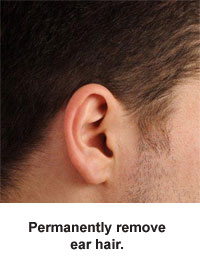How do I know if I am a candidate for electrolysis or laser hair removal?
 Since electrologists are trained in permanent hair removal, it is best to consult an electrologist first. By asking a few questions, almost always, the electrologist can determine whether you are a candidate for electrolysis or laser. In my practice, I recommend that a patient seeking hair removal makes a ¼ hour electrolysis appointment. All together, you will be in the office for no more than one-half hour including the electrolysis treatment. If you are a candidate for laser, it will be recommended at that time to start with laser and then follow up with the electrolysis. By following this procedure first, it introduces you to electrolysis for a minimum treatment and allows you to get all the electrolysis/laser information you will need to remove hair the quickest and least expensive way. Since both methods of hair removal have their advantages and limitations, a well-trained electrologist will be able to provide you with the best treatment plan that addresses your specific needs.
Since electrologists are trained in permanent hair removal, it is best to consult an electrologist first. By asking a few questions, almost always, the electrologist can determine whether you are a candidate for electrolysis or laser. In my practice, I recommend that a patient seeking hair removal makes a ¼ hour electrolysis appointment. All together, you will be in the office for no more than one-half hour including the electrolysis treatment. If you are a candidate for laser, it will be recommended at that time to start with laser and then follow up with the electrolysis. By following this procedure first, it introduces you to electrolysis for a minimum treatment and allows you to get all the electrolysis/laser information you will need to remove hair the quickest and least expensive way. Since both methods of hair removal have their advantages and limitations, a well-trained electrologist will be able to provide you with the best treatment plan that addresses your specific needs.
What is electrolysis?
In simple terms, electrolysis is a way to permanently remove hair with an electrical current by inserting a very thin sterile needle/probe into the hair follicle. The electrical current is delivered to the papilla and surrounding cells are destroyed after a series of treatments. The amount of hair, the specific area being treated, and the quantity and type of temporary methods of hair removal used prior to electrolysis all determine the length of time needed to achieve permanency. The methods of electrolysis used today are thermolysis, galvanic and the blend. Terri’s office employs all three modalities.
What is laser?
Laser removes hair by absorbing the dark pigment producing cells at the bottom of the hair follicle and then converts the light to heat. The heat damages the follicle and destroys the cells so the hair cannot re-grow. Laser is a great option for large areas of the body that have dark, dense hair. It reduces the hair significantly after six to ten treatments, but the area needs to be followed up with electrolysis to remove the remaining hairs and achieve permanency.
What does electrolysis cost?
 Electrolysis is done in increments of ¼ hour sessions up to one hour. To determine the estimated cost, you need to know how long the individual sessions will be (such as 1/4 hr., 1/2 hr., etc.) and the approximate total amount of hours necessary to remove the hairs from the area. Multiply the rate of each session by the hours to get the approximate cost. Depending on what temporary hair removal methods were used prior to electrolysis and the particular area of the body being treated, both play a part in the cost. The more coarse the hair and the larger the area, such as both legs, will contribute to the cost vs. fine hairs on an upper lip which will require less time and money.
Electrolysis is done in increments of ¼ hour sessions up to one hour. To determine the estimated cost, you need to know how long the individual sessions will be (such as 1/4 hr., 1/2 hr., etc.) and the approximate total amount of hours necessary to remove the hairs from the area. Multiply the rate of each session by the hours to get the approximate cost. Depending on what temporary hair removal methods were used prior to electrolysis and the particular area of the body being treated, both play a part in the cost. The more coarse the hair and the larger the area, such as both legs, will contribute to the cost vs. fine hairs on an upper lip which will require less time and money.
Does electrolysis hurt?
There is minimum discomfort for some patients and almost nothing for others. Mostly it depends on the area of the body as some areas are more sensitive than others. Some patients have more tolerance to pain than others and, therefore, the treatments do not bother them. Terri’s office has a cream available to numb the area before treatments.
How long do I have to let the hair grow in before having electrolysis?
It’s best to discontinue any method of temporary hair removal for at least two days, although the longer you go, the better. The hairs must be long enough for the electrologist to grasp with a tweezer-like instrument. The more you have present on the day of the treatment will allow a better visual estimate as to how long the treatment will take to achieve permanency, as well as an estimated cost.
Once I start electrolysis, can I still remove the hair with temporary methods?
Although it is generally not advisable, sometimes it may be necessary when the area being treated cannot be cleared during the first few treatments. Once the area is free from hair by regular electrolysis treatments, it is recommended to discontinue temporary hair removal methods. Electrolysis appointments are scheduled on a timely basis to avoid unnecessary embarrassment and prevent the necessity of having to engage in temporary hair removal.
Have you always gotten results with your patients?
 Yes. Electrolysis is a process that individually removes hair. The patient does not feel the needle enter the hair follicle and you should not feel the hair being removed. The electrologist uses enough current to disengage the hair for it to be removed without any resistance. Once the hair is removed, it will take approximately 3-4 weeks for the hair to re-grow from the same hair follicle. When the hair grows back, the process is repeated. The hairs become finer and finer, and less and less grow back until the follicle no longer produces any hair. This process of elimination is how electrolysis becomes permanent. The area of the body becomes smooth skin and appears as though it never had any hair once the series of treatments are completed.
Yes. Electrolysis is a process that individually removes hair. The patient does not feel the needle enter the hair follicle and you should not feel the hair being removed. The electrologist uses enough current to disengage the hair for it to be removed without any resistance. Once the hair is removed, it will take approximately 3-4 weeks for the hair to re-grow from the same hair follicle. When the hair grows back, the process is repeated. The hairs become finer and finer, and less and less grow back until the follicle no longer produces any hair. This process of elimination is how electrolysis becomes permanent. The area of the body becomes smooth skin and appears as though it never had any hair once the series of treatments are completed.
Does electrolysis cause any side effects on the skin?
Most side effects following the treatment usually consist of a mild redness that disappears within a couple of hours. On an occasion, due to sensitivity of the skin, or the length of treatment, a patient may experience tiny red lesions post-treatment if not properly taken care of. Since scarring is extremely rare, complications from electrolysis are a result of the electrologist’s skill or the equipment being used. Many patients have electrolysis before going to work or during their lunch hours and do not suffer any side effects.
What areas of the body can be treated for permanent hair removal?
The most popular areas of the body for women are: hairline, sideburns, eyebrows, nose, upper lip, lower lip, cheeks, chin, neck, chest/breasts, abdomen, underarms, arms/hands, bikini area, legs, and feet. The most common areas of the body for men are: hairline, eyebrows, beard, ears, neck, cheeks, back, chest, arms, legs, and shoulders.
